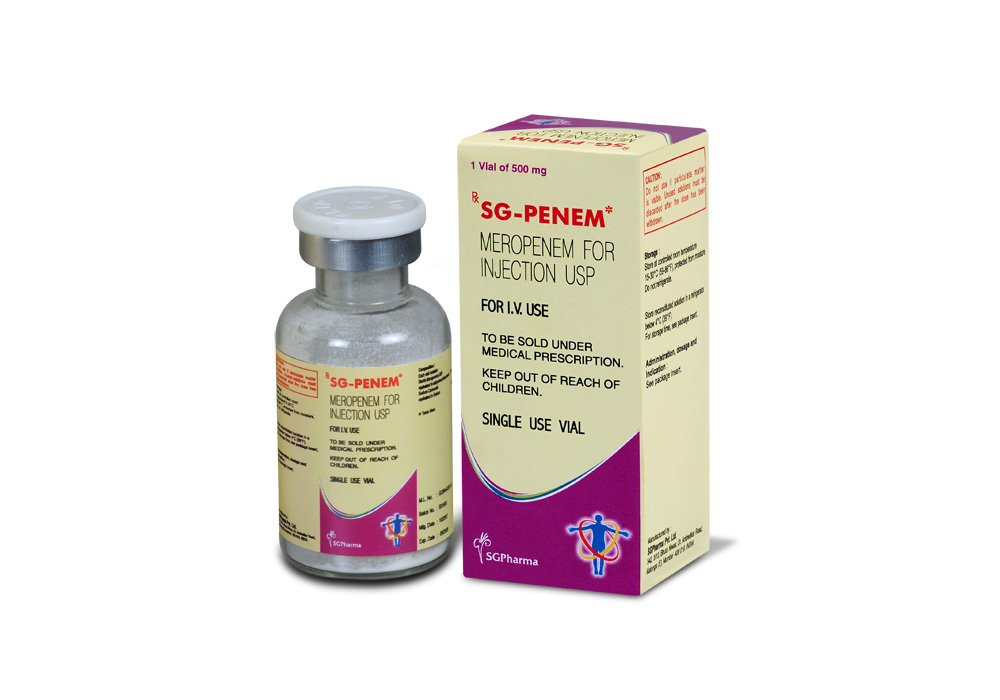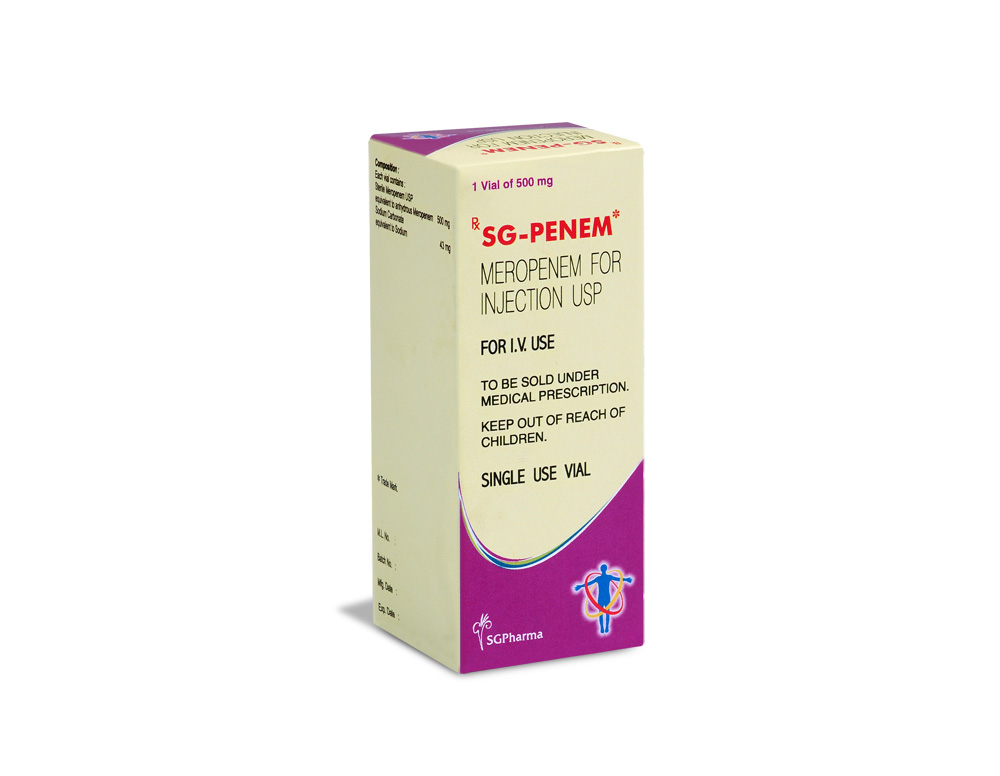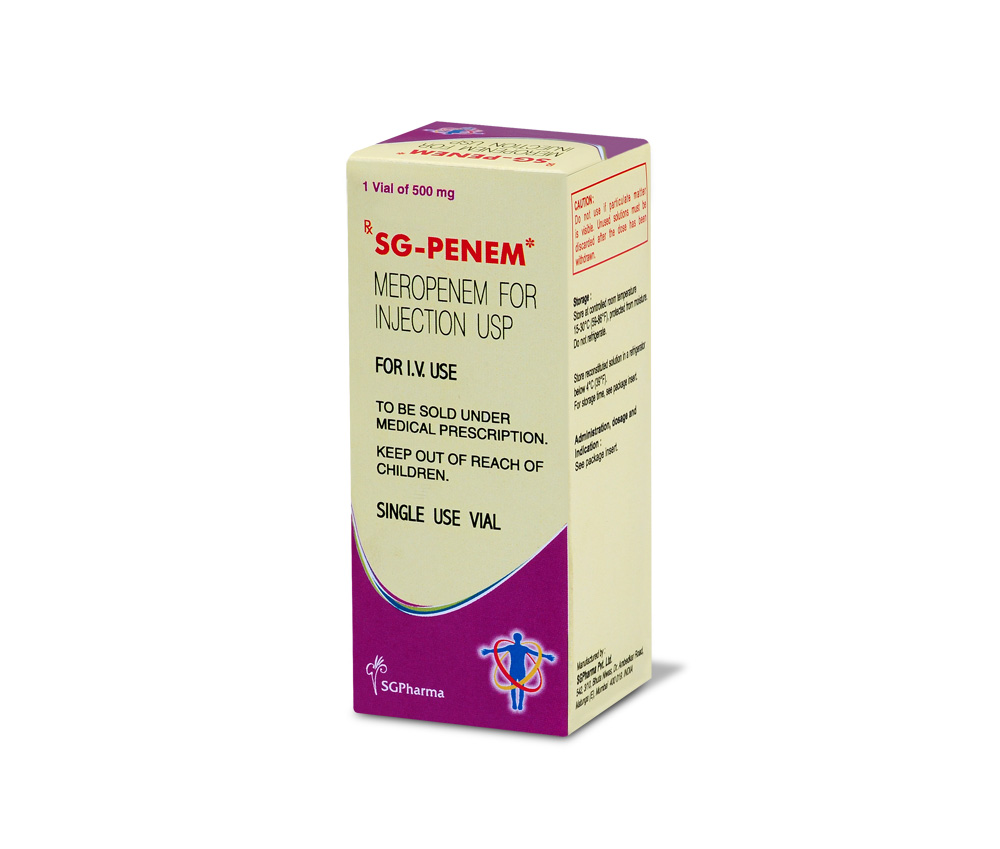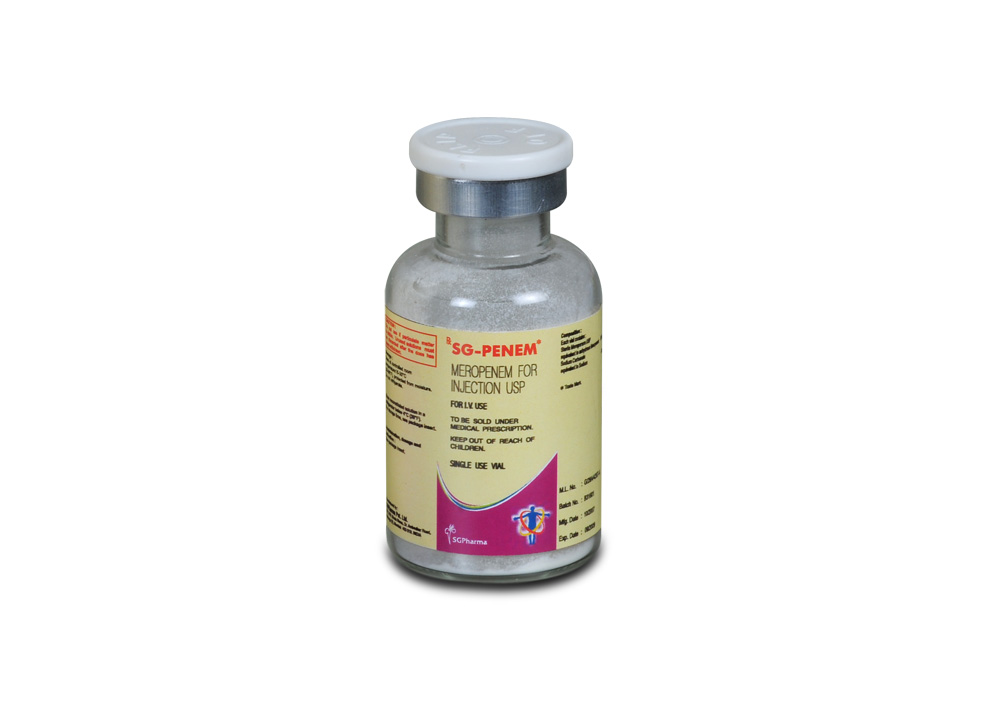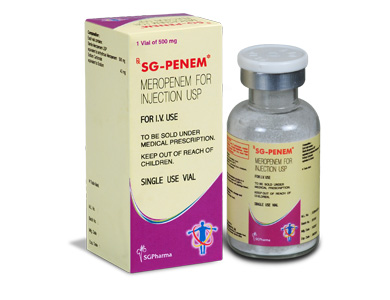
500 mg, 1 gm
For the use of a Registered Medical Practitioner or a Hospital or a Institution only.
SG-PENEM (Meropenem) is a synthetic, broad-spectrum, carbapenem antibiotic for intravenous administration. Chemically, Meropenem is (4R,5S,6S)-3-[[(3S,5S)-5-(Dimethylcarbamoyl) -3-pyrrolidinyl]thio] -6-[(1R)-1-hydroxyethyl]-4-methyl-7-oxo- 1- azabicyclo [3.2.0] hept-2-ene-carboxylic acid trihydrate. The molecular formula is C17H25N3O5S·3H2O and molecular weight is 437.52.
STRUCTURAL FORMULA :
Its structural formula is :
-Structure.jpg)
SG-PENEM is a white to pale yellow sterile, pyrogen free crystalline powder filled in vials of suitable size. The solution varies from colourless to yellow depending on the concentration.
COMPOSITION :
SG-PENEM 500 mg
Each vial contains :
Sterile Meropenem USP
equivalent to anhydrous Meropenem 500 mg
Sodium Carbonate
equivalent to Sodium 43 mg
SG-PENEM 1 gm
Each vial contains :
Sterile Meropenem USP
equivalent to anhydrous Meropenem 1 gm
Sodium Carbonate
equivalent to Sodium 86 mg
ACTIONS :
Meropenem is a carbapenem antibiotic for parenteral use, that is stable to human dehydropeptidase-I (DHP-I). It is structurally similar to imipenem. Meropenem exerts its bactericidal action by interfering with vital bacterial cell wall synthesis. The ease with which it penetrates bacterial cells, its high level of stability to all serine ß-lactamases and its marked affinity for the Penicillin Binding Proteins (PBPs) explain the potent bactericidal activity of meropenem against a broad spectrum of aerobic and anaerobic bacteria. The bactericidal concentrations are generally within one doubling dilution of the minimum inhibitory concentrations (MICs).
PHARMACOKINETICS :
At the end of a 30-minute intravenous infusion of a single dose of SG-PENEM in normal volunteers, mean peak plasma concentrations are approximately 23 µg/ml (range 14-26) for the 500 mg dose and 49 µg/ml (range 39-58) for the 1 g dose. A 5-minute intravenous bolus injection of SG-PENEM in normal volunteers results in mean peak plasma concentrations of approximately 45 µg/ml (range 18-65) for the 500 mg dose and 112 µg/ml (range 83-140) for the 1 g dose. Following intravenous doses of 500 mg, mean plasma concentrations of meropenem usually decline to approximately 1 µg/ml at 6 hours after administration. In subjects with normal renal function, the elimination half-life of SG-PENEM is approximately 1 hour. Approximately 70 % of the intravenously administered dose is recovered as unchanged meropenem in the urine over 12 hours, after which little further urinary excretion is detectable. Urinary concentrations of meropenem in excess of 10 µg/ml are maintained for up to 5 hours after a 500 mg dose. No accumulation of meropenem in plasma or urine was observed with regimens using 500 mg administered every 8 hours or 1g administered every 6 hours in volunteers with normal renal function. Plasma protein binding of meropenem is approximately 2 %.
There is one metabolite which is microbiologically inactive. Meropenem penetrates well into most body fluids and tissues including cerebrospinal fluid, achieving concentrations matching or exceeding those required to inhibit most susceptible bacteria. After a single intravenous dose of SG-PENEM, the highest mean concentrations of meropenem were found in tissues and fluids at 1 hour (0.5 to 1.5 hours) after the start of infusion, except where indicated in the tissues and fluids listed in the table below.
-Table-1.jpg)
The pharmacokinetics of SG-PENEM in paediatric patients 2 years of age or older are essentially similar to those in adults. The elimination half-life for meropenem was approximately 1.5 hours in paediatric patients of age 3 months to 2 years. The pharmacokinetics are linear over the dose range from 10 to 40 mg/kg. Pharmacokinetic studies with SG-PENEM in patients with renal insufficiency have shown that the plasma clearance of meropenem correlates with creatinine clearance. Dosage adjustments are necessary in subjects with renal impairment. A pharmacokinetic study with SG-PENEM in elderly patients with renal insufficiency has shown a reduction in plasma clearance of meropenem that correlates with age-associated reduction in creatinine clearance. Meropenem I.V. is haemodialyzable. However, there is no information on the usefulness of haemodialysis to treat overdosage. A pharmacokinetic study with SG-PENEM in patients with hepatic impairment has shown no effects of liver disease on the pharmacokinetics of meropenem.
Microbiology :
The bactericidal activity of meropenem results from the inhibition of cell wall synthesis. Meropenem readily penetrates the cell wall of most gram-positive and gram-negative bacteria to reach penicillin-binding-protein (PBP) targets. Its strongest affinities are toward PBPs
2, 3 and 4 of Escherichia coli and Pseudomonas aeruginosa; and PBPs 1, 2, and 4 of Staphylococcus aureus. Bactericidal concentrations (defined as a 3 log 10 reductions in cell counts within 12 to 24 hours) are typically 1-2 times the bacteriostatic concentrations of
meropenem, with the exception of Listeria monocytogenes, against which lethal activity is not observed. Meropenem has significant stability to hydrolysis by (beta)-lactamases of most categories, both penicillinases and cephalosporinases produced by gram-positive and gram-negative bacteria, with the exception of metallo-(beta)-lactamases. Meropenem should not be used to treat methicillin-resistant staphylococci. Cross resistance is sometimes observed with strains resistant to other carbapenems. In vitro tests show meropenem to act synergistically with aminoglycoside antibiotics against some isolates of Pseudomonas aeruginosa. Meropenem has been shown to be active against most strains of the following microorganisms, both in vitro and in clinical infections as described in the INDICATIONS section.
Dilution Techniques :
Quantitative methods are used to determine antimicrobial minimum inhibitory concentrations (MIC’s). These MIC’s provide estimates of the susceptibility of bacteria to antimicrobial compounds. The MIC’s should be determined using a standardized procedure. Standardized procedures are based on a dilution method 1 (broth or agar) or equivalent with standardized inoculum concentrations and standardized concentrations of meropenem powder. The MIC values should be interpreted according to the following criteria for indicated aerobic organisms other than Haemophilus species and streptococci :
-Table-2.jpg)
The current absence of resistant strains precludes defining any categories other than “Susceptible”. Strains yielding results suggestive of a “Nonsusceptible” category should be submitted to a reference laboratory for further testing. A report of ‘Susceptible’ indicates that the pathogen is likely to be inhibited if the antimicrobial compound in the blood reaches the concentrations usually achievable. A report of ‘Intermediate’ indicates that the result should be considered equivocal, and, if the microorganism is not fully susceptible to alternative, clinically feasible drugs, the test should be repeated. This category implies possible clinical applicability in body sites where the drug is physiologically concentrated or in situations where high dosage of drug can be used. This category also provides a buffer zone which prevents small uncontrolled technical factors from causing major discrepancies in interpretation. A report of ‘Resistant’ indicates that the pathogen is not likely to be inhibited if the antimicrobial compound in the blood reaches the concentrations usually
achievable; other therapy should be selected. Standardized susceptibility test procedures require the use of laboratory control microorganisms to control the technical aspects of the laboratory procedures. Standard meropenem powder should provide the following MIC values :
Diffusion Techniques :
Quantitative methods that require measurement of zone diameters also provide reproducible estimates of the susceptibility of bacteria to antimicrobial compounds. One such standardized procedure 2 requires the use of standardized inoculum concentrations. This procedure uses paper disks impregnated with 10-µg of meropenem to test the susceptibility of microorganisms to meropenem. Reports from the laboratory providing results of the standard single-disk susceptibility test with a 10-µg disk should be interpreted according to the following criteria for indicated aerobic organisms other than Haemophilus species and streptococci :
-Table-3.jpg)
The current absence of resistant strains precludes defining any categories other than “Susceptible”. Strains yielding results suggestive of a “Nonsusceptible” category should be submitted to a reference laboratory for further testing. Streptococcus pneumoniae isolates should be tested using 1-µg/ml oxacillin disk. Isolates with oxacillin zone sizes of >/= 20 mm are susceptible (MIC < /= 0.06 µg/ml) to penicillin and can be considered susceptible to meropenem for approved indications, and meropenem need not be tested. A meropenem MIC should be determined on isolates of S. pneumoniae with oxacillin zone sizes of </= 19 mm. The disk test does not distinguish penicillin intermediate strains (i.e., MIC’s = 0.12-1.0 µg/ml) from strains that are penicillin resistant (i.e., MIC’s >/= 2 µg/ml). Viridans group streptococci should be tested for meropenem susceptibility using an MIC method. Reliable disk diffusion tests for meropenem do not yet exist for testing streptococci.
Interpretation should be as stated above for results using dilution techniques. Interpretation involves correlation of the diameter obtained in the disk test with the MIC for meropenem. As with standardized dilution techniques, diffusion methods require the use of laboratory control microorganisms that are used to control the technical aspects of the laboratory procedures. For the diffusion technique, the 10-µg meropenem disk should provide the following zone dia-meters in these laboratory test quality control strains.
INDICATIONS :
To reduce the development of drug-resistant bacteria and maintain the effectiveness of SG-PENEM and other antibacterial drugs, SG-PENEM should only be used to treat or prevent infections that are proven or strongly suspected to be caused by susceptible bacteria.
When culture and susceptibility information are available, they should be considered in selecting or modifying antibacterial therapy. In the absence of such data, local epidemiology and susceptibility patterns may contribute to the empiric selection of therapy.
SG-PENEM is indicated as single agent therapy for the treatment of the following infections when caused by susceptible strains of the designated microorganisms :
Intra-abdominal Infections
Complicated appendicitis and peritonitis caused by viridans group streptococci, Escherichia coli, Klebsiella pneumoniae, Pseudomonas aeruginosa, Bacteroides fragilis, B. thetaiotaomicron, and Peptostreptococcus species. Bacterial Meningitis (Pediatric patients >/= 3 months only) Bacterial meningitis caused by Streptococcus pneumoniae **/**, Haemophilus influenzae ((beta)-lactamase and non-(beta)-lactamase-producing strains), and Neisseria meningitidis . **/** The efficacy of meropenem as monotherapy in the treatment of meningitis caused by penicillin nonsusceptible strains of Streptococcus pneumoniae has not been established. SG-PENEM has been found to be effective in eliminating concurrent bacteremia in association with bacterial meningitis. For information regarding use in paediatric patients (3 months of age and older) see PRECAUTIONS - Paediatrics, ADVERSE REACTIONS, and DOSAGE AND ADMINI-STRATION sections. Appropriate cultures should usually be performed before initiating antimicrobial treatment in order to isolate and identify the organisms causing infection and determine their susceptibility to SG-PENEM SG-PENEM is useful as presumptive therapy in the indicated condition (i.e., intra-abdominal infections) prior to the identification of the causative organisms because of its broad spectrum of bactericidal activity. Antimicrobial therapy should be adjusted, if appropriate, once the results of culture(s) and antimicrobial susceptibility testing are known.
Administration :
SG-PENEM to be used for bolus intravenous injection should be constituted with sterile water for injection (10 ml per 500 mg meropenem). This provides an approximate available concentration of 50 mg/ml. Constituted solutions are clear or pale yellow. SG-PENEM for intravenous infusion may be directly constituted with a compatible infusion fluid (see COMPATIBILITY) and then further diluted (50 to 200 ml) with the compatible infusion fluid, as needed.
Compatibility and Stability :
Compatibility of SG-PENEM with other drugs has not been established. SG-PENEM should not be mixed with or physically added to solutions containing other drugs. Freshly prepared solutions of SG-PENEM should be used whenever possible. However, constituted solutions of SG-PENEM maintain satisfactory potency at controlled room temperature 15-25°C (59-77°F) or under refrigeration at 4°C (39°F) as described below. Solutions of intravenous SG-PENEM should not be frozen.
Intravenous Bolus Administration
SG-PENEM injection vials constituted with sterile Water for Injection for bolus administration (up to 50 mg/ml of SG-PENEM) may be stored for up to 2 hours at controlled room temperature 15-25°C (59-77°F) or for up to 12 hours at 4°C (39°F).
Intravenous Infusion Administration
Stability in Infusion Vials : SG-PENEM infusion vials onstituted with Sodium Chloride Injection 0.9 % (SG-PENEM concentrations ranging from 2.5 to 50 mg/ml) are stable for up to 2 hours at controlled room temperature 15-25°C (55-77°F) or for up to 18 hours at 4°C (39°F). Infusion vials of SG-PENEM constituted with Dextrose Injection 5 % (SG-PENEM concentrations ranging from 2.5 to 50 mg/ml) are stable for up to 1 hour at controlled room temperature 15-25°C (59-77°F) or for up to 8 hours at 4°C (39°F). Stability in Plastic I.V. Bags : Solutions prepared for infusion (SG-PENEM concentrations ranging from 1 to 20 mg/ml) may be stored in plastic intravenous bags with diluents as shown below :
-Table-4.jpg)
Dosage :
A) Adults
Dosage range is 1.5 g - 6 g daily in three divided doses.
Usual dose
500 mg to 1 g by intravenous administration every 8 hours depending on type and severity of infection, the known or expected susceptibility of the pathogen(s) and the condition of the patient.
Exceptions
1. Febrile episodes in neutropenic patients - the dose should be 1 g every 8 hours.
2. Meningitis - the dose should be 2 g every 8 hours.
As with other antibiotics, caution may be required in using meropenem as monotherapy in critically ill patients with known or suspected Pseudomonas aeruginosa lower respiratory tract infections. Regular sensitivity testing is recommended when treating Pseudomonas aeruginosa infections. SG-PENEM should be given as an intravenous bolus injection over approximately 5 minutes or by intravenous infusion over approximately 15 to 30 minutes (see Method of Administration).
CONTRAINDICATIONS :
SG-PENEM is contraindicated in patients who have demonstrated hypersensitivity to this product or to other drugs in the same class or in patients who have demonstrated anaphylactic reactions to β-lactams. Seizures and other CNS adverse experiences have been reported during treatment with SG-PENEM. Pseudomembranous colitis has been reported with nearly all antibacterial agents, including meropenem, and may range in severity from mild to life-threatening. Therefore, it is important to consider this diagnosis in patients who present with diarrhoea subsequent to the administration of antibacterial agents. Treatment with antibacterial agents alters the normal flora of the colon and may permit overgrowth of clostridia. Studies indicate that a toxin produced by Clostridium difficile is a primary cause of “antibiotic-associated colitis”. After the diagnosis of pseudomembranous colitis has been established, therapeutic measures should be initiated. Mild cases of pseudomembranous colitis usually respond to drug discontinuation alone. In moderate-to-severe cases, consideration should be given to management with fluids and electrolytes, protein supplementation, and treatment with an antibacterial drug clinically effective against Clostridium difficile colitis.
PRECAUTIONS :
General : Prescribing SG-PENEM in the absence of a proven or strongly suspected bacterial infection or a prophylactic indication is unlikely to provide benefit to the patient and increases the risk of the development of drug-resistant bacteria. Seizures and other adverse CNS experiences have been reported during treatment with SG-PENEM. These experiences have occurred most commonly in patients with CNS disorders (e.g., brain lesions or history of seizures) or with bacterial meningitis and/or compromised renal function. Close adherence to the recommended dosage regimens is urged, especially in patients with known factors that predispose to convulsive activity. Anticonvulsant therapy should be continued in patients with known seizure disorders. If focal tremors, myoclonus, or seizures occur, patients should be evaluated neurologically, placed on anticonvulsant therapy if not already instituted, and the dosage of SG-PENEM re-examined to determine whether it should be decreased or the antibiotic discontinued. In patients with renal dysfunction, thrombocytopenia has been observed but no clinical bleeding reported. There is inadequate information regarding the use of SG-PENEM in patients on haemodialysis. As with other broad-spectrum antibiotics, prolonged use of meropenem may result in overgrowth of non susceptible organisms. Repeated evaluation of the patient is essential. If superinfection does occur during therapy, appropriate measures should be taken.
Laboratory Tests : While SG-PENEM possesses the characteristic low toxicity of the beta-lactam group of antibiotics, periodic assessment of organ system functions, including renal, hepatic, and haematopoietic, is advisable during prolonged therapy.
Drug Interactions : Probenecid competes with meropenem for active tubular secretion and thus inhibits the renal excretion of meropenem. This led to statistically significant increases in the elimination half-life (38 %) and in the extent of systemic exposure (56 %). Therefore, the coadministration of probenecid with meropenem is not recommended. There is evidence that meropenem may reduce serum levels of valproic acid to subtherapeutic levels (therapeutic range considered to be 50 to 100 µg/ml total valproate).
Pregnancy : Category B
The safety of SG-PENEM in human pregnancy has not been established, although animal studies have not shown an adverse effect on the developing foetus. SG-PENEM should not be used in pregnancy unless the potential benefit justifies the potential risk to the foetus.
Nursing mothers :
Meropenem is detectable at very low concentrations in animal breast milk. SG-PENEM should not be used in breast-feeding women unless the potential benefit justifies the potential risk to the baby.
In children :
Efficacy and tolerability in infants under 3 months old have not been established; therefore, SG-PENEM is not recommended for use below this age. Effect on Ability to Drive or Operate Machinery No data are available, but it is not anticipated that SG-PENEM will affect the ability to drive and operate machinery.
INTERACTIONS AND INCOMPATIBILITIES :
Probenecid competes with meropenem for active tubular secretion and thus inhibits the renal excretion of meropenem with the effect of increasing the elimination half-life and plasma concentration of meropenem. As the potency and duration of action of SG-PENEM dosed without probenecid are adequate the co-administration of probenecid with SG-PENEM is not recommended. The potential effect of SG-PENEM on the protein binding of other medicines or metabolism has not been studied. However, the protein binding is so low (approximately 2 %) that no interactions with other compounds would be expected on the basis of this mechanism. SG-PENEM has been administered concomitantly with many other medications without apparent adverse interaction. SG-PENEM may reduce serum valproic acid levels. Subtherapeutic levels may be reached in some patients. However, no specific drug interaction studies other than with probenecid were conducted.
SIDE EFFECTS :
SG-PENEM is generally well tolerated. Adverse events rarely lead to cessation of treatment. Serious adverse events are rare.
-Table-5.jpg)
OVERDOSAGE AND TREATMENT OF OVERDOSAGE :
Intentional overdosing of SG-PENEM is unlikely, although overdosing could occur during therapy particularly in patients with renal impairment. Limited post-marketing experience indicates that if adverse events occur following overdosage, they are consistent with the adverse event profile described in SIDE EFFECTS, are generally mild in severity and resolve on withdrawal or dose reduction. Symptomatic treatments should be considered. In normal individuals rapid renal elimination will occur. Haemodialysis will remove SG-PENEM and its metabolite.
PHARMACEUTICAL PRECAUTIONS :
Parenteral drug products should be inspected visually for particulate matter and discoloration prior to administration, whenever solution and container permit.
STORAGE :
Store at controlled room temperature 30°C, protected from moisture and light.
Do not refrigerate.
SHELF LIFE :
24 months from the date of manufacture.
PRESENTATION :
SG-PENEM 500 mg SG-PENEM contains Sterile Meropenem USP equivalent to anhydrous Meropenem 500 mg.
Single vial pack.
SG-PENEM 1 gm
SG-PENEM contains Sterile Meropenem USP equivalent to anhydrous Meropenem 1 gm.
Single vial pack.
Disclaimer : For the use of a Registered Medical Practitioner or a Hospital or a Institution only. Also it is not intended to be used by healthcare professionals or patients for the purpose of prescribing or administering these products. Questions regarding the complete and current content of product labeling / specification / presentation should be directed to SGPharma.

 Cardiovascular
Cardiovascular



